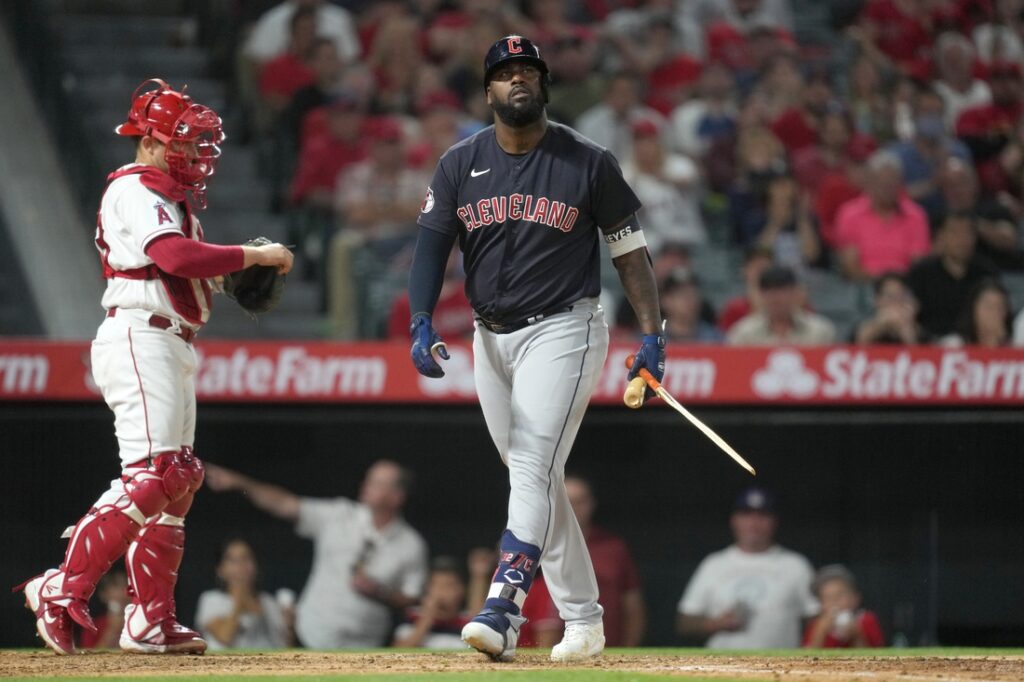Andrew Luck was certainly good in Saturday’s win over the Houston Texans, but he was far from perfect.
He had two throws batted from relatively clean pockets (one led to a pick), another throw cornerback Johnathan Joseph undercut for a near interception, and a few ball-placement issues while failing to score in the second half.
Such mistakes are completely normal for a top quarterback, but they might have sunk Indianapolis Colts teams of old. Instead, with his offensive line putting on a clinic — and, of course, great defense — Luck and the Colts cruised to the divisional playoffs with a 21-7 win.

Indianapolis’ improvement up front is no secret, but Saturday in Houston might have been the group’s best performance yet. It downright dominated J.J. Watt, Jadeveon Clowney & Co., with help from Frank Reich and his staff.
The Colts greeted the Texans’ league-best run defense (3.4 yards per carry allowed) with a dizzying array of designs. Indianapolis ran inside zone, outside zone, split zone, iso lead, power (sometimes with a pulling guard, sometimes a pulling tackle), counter, trap/wham and a few pin-and-pull schemes — almost all before halftime. They ran from under center and from shotgun, mixing in various motions and a sixth offensive lineman at tight end.
Indy’s second series was a perfect showcase. First, a pin-and-pull concept sprung Marlon Mack for 25 yards. After Mack gained eight yards on a tight-end wham, two runs behind H-back Ryan Hewitt moved the chains. Reich then called a crafty reverse to Zach Paschal, with All-Pro rookie left guard Quenton Nelson — the team’s favorite puller — pulling right to fake a power run while down-blockers leaked left. Paschal gained 14 but would have scored with better vision. No matter — after a counter run was stuffed, Mack punched it in three plays later on outside zone.
Not every design worked, but the constant churn of schemes kept Houston defenders off balance. That’s a credit to the staff but also to the line, as such a voluminous plan requires extensive preparation and chemistry. Many teams rely on two or three core runs all year because they trust little else, but this group can handle myriad concepts and still plow opponents off the line.
By game’s end, left tackle Anthony Castonzo, Nelson, center Ryan Kelly, right guard Mark Glowinski and right tackle Braden Smith (another rookie) had walloped the Texans so thoroughly that Mack gained 41 yards on two inside-zone runs — the most basic of downhill runs — on his final two carries. (To his credit, the slithery but strong Mack ran extremely well all day.)
Houston was surely demoralized it could barely reached Luck, who wasn’t sacked and took just four hits. Even that might understate the protection, as Luck had time to camp out and make s’mores on several occasions. The game plan helped with chips to Watt’s side and plenty of play-action, but the Colts mostly just won their blocks.
Castonzo was nearly flawless, while Nelson and Kelly shined against stunts, twists and blitzes, often stoning a looping Clowney or Whitney Mercilus. Nelson continued to show uncanny polish for a rookie, “splashing” rushers (chopping the defender’s hands down so he falls on his face) or simply locking on and burying them. Smith more than held his own against Watt, playing properly to chip help and varying his sets to keep Watt guessing.
The group weathered a flurry of Texans blitzes late, and it was especially sharp on third downs throughout. On Luck’s first and last third-down attempts, his pocket looked like the Oval Office, giving him time to find T.Y. Hilton for 12- and 20-yard daggers.
When Houston did get close — Glowinski, most notably, lost a handful of reps — rarely were two Colts beaten on the same play, giving Luck an otherwise clean pocket to avoid one rusher. He stepped up calmly on a few throws and also escaped at times, including a 9-yard gain on third-and-6 after hanging in the pocket for nearly five full seconds.
Pristine protection let Reich dial up several longer developing routes, like Hilton’s 38-yard gain — from an empty formation — to set up the first touchdown. Most teams throw quick and short out of empty (before protection can break down), but Reich went empty knowing Houston would check to Tampa-2 coverage so he could isolate Hilton on linebacker Benardrick McKinney deep. Smith held up just long enough against Watt for Hilton — whose release was disrupted at the line — to get behind McKinney.
TY Hilton owns the Texans 🤡 pic.twitter.com/XCVDGqg49J
— Barstool Sports (@barstooltweetss) January 5, 2019
Similarly, Indy’s third TD drive featured two post-corner routes for Dontrelle Inman, with a deep stem and fake inside before breaking outside. It’s a very difficult route to cover — Kareem Jackson and then Shareece Wright were shaken easily — but also requires plenty of time to come open. Luck had all day on both plays, resulting in a 21-yard gain and 18-yard score.
Luck to @mrinman15 for another 6! #INDvsHOU pic.twitter.com/vQCX83mTRS
— Indianapolis Colts (@Colts) January 5, 2019
With his line shining, Reich can feel free to call almost anything, a scary proposition for defenses when Luck is the one pulling the trigger.
And when Luck isn’t at his absolute best, that’s OK. More than anything, the Colts’ front has widened his margin for error, giving this team all kinds of ways to win.
How L.A. stymied Jackson, and what’s next

Sooner or later, an opponent was bound to solve the Baltimore Ravens’ spread-option, Lamar Jackson-led run game.
It was no coincidence that the Los Angeles Chargers — the first team to get a second crack at the new-look offense — were that team. After adapting well in Week 16 (75 yards allowed on the final 27 carries), the Bolts learned from their own approach and from what others have done against the Ravens.
In Week 17, the Browns found success late vs. Baltimore by putting four D-linemen between the offensive tackles (often after a late shift), using the extremely tight alignment to jam the middle. The Chargers rarely put four in such tight quarters Sunday, but they often put three over the guards and center (creating a “bear” front) and then took it a step further by complementing with seven defensive backs.
Using lighter personnel to stop the run sounds bonkers, but it was ideal in this case for a few reasons. For one, more speed would help corral the Ravens’ option designs that threaten the perimeter. More importantly, with defensive linemen aligned tight inside, Baltimore offensive linemen would be unable to double team and have less room to climb to the second level. That would keep box safeties Derwin James, Adrian Phillips and Jahleel Addae (fourth safety Rayshawn Jenkins played deep) clean to scrape and flow to the ball.
James played mostly on the edge as a pseudo 3-4 outside linebacker — a role that suits his size and aggression — opposite Melvin Ingram, while Joey Bosa kicked toward the interior. Ingram was aggressive shooting gaps and attacking the ball carrier when left unblocked, knowing he had safeties to help clean up if he missed.
Those extra safeties also gave the Chargers more speed in coverage between the numbers, where Jackson is most comfortable as a thrower. They clogged the middle of the field, and also helped when spying Jackson and when getting depth quickly after play-fakes. On Jackson’s interception, Phillips took a step forward on play-action but quickly sunk deep enough to corral the ball after Casey Hayward broke up Jackson’s high throw.
YASSSS, AP. @Phillips_17 | #LACvsBAL pic.twitter.com/X5MM8VTaFX
— Los Angeles Chargers (@Chargers) January 6, 2019
With easy throws taken away, the run game stymied and the Ravens trailing big, Jackson’s rawness as a passer was exposed.
Given his electric gifts, Jackson’s tendency is to hold the ball and try to create when his first read isn’t open, but that tactic puts a heavy burden on protection. Filling in for injured left guard Alex Lewis, James Hurst was a disaster, allowing three sacks (including two on consecutive plays) to three different players. Bradley Bozeman replaced Hurst late and wasn’t any better, allowing a sack to Melvin Ingram and getting tossed at Jackson’s feet by T.Y. McGill to create another.
By the 9:09 mark of the fourth quarter, Jackson was 3 for 10 for 25 yards while taking five sacks for 27 yards. Baltimore’s designed shot plays were thwarted by pressure — with James closing on the fourth play from scrimmage, Jackson failed to pull the trigger on a potential TD bomb to Michael Crabtree — or disciplined coverage. Jackson couldn’t compensate with any form of a rhythmic passing game.

While that’s an indictment on the rookie’s ability through the air, it’s also not a huge surprise. In college, Jackson’s mechanics and ball placement were erratic at times (especially outside the numbers), and he was up-and-down reading the field. He’s made progress mechanically through eight NFL starts, but these things take time.
The Ravens knew this when they drafted Jackson. They went all-in on him because of all of the other unique things he can do, and they overhauled their run game around him this year to buy time while he develops as a thrower.
Jackson doesn’t ever have to become a pick-you-apart precision passer. His ability to create — which was a major part of Sunday’s late comeback bid — will always be his equalizer, much like it was for Michael Vick in his Falcons days. He also brings tremendous value in the run game, assuming he can stay healthy.
Baltimore’s offense will evolve next season, and Jackson’s role as a runner will surely be toned down — he set a modern-era QB record with 147 regular-season carries despite just seven starts. But Jackson will also grow as a passer, and the Ravens will spend the whole offseason shaping their scheme (and roster) to fit him.
If the defense and run game remain strong — and there’s no reason to think they won’t — Jackson will have an ideal environment in which to develop. Who knows how he’ll look this time next year?
Cowboys flash offensive creativity late

Coordinator Scott Linehan’s passing game is mostly static.
As we covered in Week 6 — when the Cowboys made some rare forays outside the box — Dallas primarily relies on isolation routes that work independent of each other, requiring receivers to beat coverage without much schemed help.
That didn’t change much in Saturday’s win over Seattle, but there were some refreshing exceptions, most notably in the fourth quarter.
After a short run to open the frame, Dak Prescott went no-huddle and got the Cowboys into an empty formation. The tempo and formation led the Seahawks to check into a simple Tampa-2 coverage, which was easily identifiable presnap. (Like in the Colts section above, many teams check automatically to Tampa-2 vs. empty formations.)
Dallas then ran a dagger concept — a perfect Tampa-2 beater — with Dalton Schultz running vertical from the inside slot to lift Bobby Wagner’s deep zone and Amari Cooper running a dig in the gaping void. Even with the throw behind, Cooper easily added 20 yards after the catch for a 34-yard gain. It was textbook scheming, as the Cowboys used tempo to get the look they wanted, then exploited it with the ideal route concept.
🗣COOOOOOOOOOPPPPP#FinishThisFight pic.twitter.com/UdiI8giIBT
— Dallas Cowboys (@dallascowboys) January 6, 2019
To start Dallas’ next possession, Linehan again schemed Cooper open, this time taking a page from the Seahawks’ playbook with a boot throwback. Prescott rolled right as Cooper (counter intuitively) worked left, running a deep over from the right slot. The boot created plenty of time for Cooper to run away from Justin Coleman and give Prescott an easy target. With a better throw, it could have been a touchdown, but Dallas picked up 27 yards.
Those were the Cowboys’ only two passes to gain more than 15 yards all game.
Even Prescott’s interception — just after Cooper’s 27-yarder — was a terrific design that should have produced another big play.
Linehan showed a run-heavy look with two tight ends and wideout Noah Brown (nominally a blocker) motioning toward the formation as if to block. At the snap, Brown did indeed block — getting cornerback Shaquill Griffin to bite from his Cover-3 zone — but then released vertically as Prescott play-faked. With Griffin biting, only linebacker K.J. Wright could cover Brown, as free safety Tedric Thompson keyed on Cooper on the opposite side. However, Prescott’s throw was well short and behind, turning a would-be walk-in touchdown into a juggling pick.
.@KJ_WRIGHT34, WAS THAT EVEN REAL?!?!#GoHawks | #SEAvsDAL pic.twitter.com/3C1WXNyabG
— Seattle Seahawks (@Seahawks) January 6, 2019
Dallas’ offense isn’t going to transform overnight — Ezekiel Elliott remains the centerpiece — but every team needs designs like these to manufacture explosive plays. Linehan deserves credit for dialing them up, and he must continue to do so as the playoffs continue.
Of course, Prescott must also be a little sharper when the designs work as planned.
–David DeChant (@DavidDeChant), Field Level Media






























